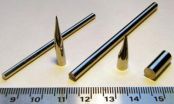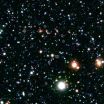(Press-News.org) Researchers at the University of British Columbia and Vancouver Coastal Health Research Institute have discovered that the genetic mechanism which destroys brain cells is responsible for early development of Alzheimer's Disease in people with Down Syndrome and for development of Alzheimer's Disease in general population – providing a potential new target for drugs that could forestall dementia in people with either condition.
The research, led by Dr. Weihong Song, Canada Research Chair in Alzheimer's Disease and a professor of psychiatry in the UBC Faculty of Medicine, found that excessive production of a protein, called Regulator of Calcineurin 1 (RCAN1), sets in motion a chain reaction that kills neurons in the hippocampus and cortex in people with Down Syndrome and Alzheimer's Disease. The findings were published online recently in the Journal of Biological Chemistry.
"Neuronal death is the primary reason for the memory loss and other cognitive impairments of Alzheimer's Disease, and it's the main reason people with Down Syndrome develop Alzheimer's Disease long before most people, usually in their 30s," says Song, a member of the Brain Research Centre at UBC and the Vancouver Coastal Health Research Institute (VCHRI), and Director of Townsend Family Laboratories at UBC. "By looking for the common elements of both conditions, we were able to pinpoint how and why the deterioration occurs."
Alzheimer's Disease (AD) is the most common form of dementia, which usually affects people over age 60. The Alzheimer Society of Canada estimates that the disease affects more than 238,000 Canadians, and that by 2031 about 750,000 Canadians will suffer from AD and related dementias.
Down Syndrome (DS) is a congenital anomaly that includes developmental delays and learning disabilities. A 2002 report by the Public Health Agency of Canada said that about one in 800 Canadian newborns have the condition; the average lifespan for those with Down Syndrome is 49 years. People with DS have an extra copy of the gene that produces RCAN1, thus leading to its excess production. The resulting neuronal death – with symptoms that mirror those of AD patients – is one of the prime reasons for the shortened lifespan of people with DS.
The research team discovered that some AD patients have similarly elevated levels of the RCAN1 protein, despite having two copies of the responsible gene. It's still unknown why, though Dr. Song speculates that the gene's overexpression might be triggered by stroke, hypertension or the presence of a neurotoxic protein, called beta amyloid, that typically collects into clumps in the brains of people with AD – what he describes as a "vicious cycle" in which one destructive factor exacerbates another.
But now that the culprit gene and protein have been identified, "we can develop therapies that interfere with the gene's ability to produce that protein, and hopefully short-circuit the destruction of brain cells," Dr. Song says.
INFORMATION:
The research was supported by the Canadian Institutes of Health Research, the Jack Brown and Family Alzheimer's Research Foundation, the Michael Smith Foundation for Health Research and the National Natural Science Foundation of China.
Townsend Family Laboratories was established at The University of British Columbia with a donation of $7.5 million from the David Townsend Family. The research centre is dedicated to integrating the basic and clinical research for finding the underlying mechanism and novel diagnostic biomarkers for Alzheimer's Disease and developing interventions to prevent and treat this devastating disease.
The UBC Faculty of Medicine provides innovative programs in the health and life sciences, teaching students at the undergraduate, graduate and postgraduate levels, and generates more than $200 million in research funding each year. In 2007/08, out of the total UBC research endeavour, 53 per cent, or $247 million, came from academic and clinical teams in the Faculty of Medicine. For more information, visit www.med.ubc.ca.
The Brain Research Centre comprises more than 200 investigators with multidisciplinary expertise in neuroscience research ranging from the test tube, to the bedside, to industrial spin-offs. The centre is a partnership of UBC and VCH Research Institute. For more information, visit www.brain.ubc.ca.
Vancouver Coastal Health Research Institute (VCHRI) is the research body of Vancouver Coastal Health Authority, which includes BC's largest academic and teaching health sciences centres: VGH, UBC Hospital, and GF Strong Rehabilitation Centre. In academic partnership with the University of British Columbia, VCHRI brings innovation and discovery to patient care, advancing healthier lives in healthy communities across British Columbia, Canada, and beyond. www.vchri.ca.
UBC-VCH researchers find critical link between Down syndrome and Alzheimer's disease
2011-01-13
ELSE PRESS RELEASES FROM THIS DATE:
How children cope with the aftermath of a hurricane
2011-01-13
CORAL GABLES, FL (January 12, 2011) --Living through a natural disaster is a traumatic experience for everyone, but especially for children. A new study by University of Miami Psychologist Annette La Greca and her collaborators, indicate that some children who directly experience a devastating hurricane still show signs of posttraumatic stress (PTS) almmost two years after the event. The findings suggest that new models for intervention to help children after a natural disaster are needed.
The study, titled "Hurricane-Related Exposure Experiences and Stressors, Other Life ...
Middle school is when the right friends may matter most
2011-01-13
EUGENE, Ore. -- (Jan. 12, 2011) -- As adolescents move from elementary school into their middle or junior-high years, changes in friendships may signal potential academic success or troubles down the road, say University of Oregon researchers.
A new study, appearing in the February issue of the Journal of Early Adolescence, found that boys and girls whose friends are socially active in ways where rules are respected do better in their classroom work. Having friends who engage in problem behavior, in contrast, is related to a decrease in their grades. Having pro-social ...
Attention ladies and gentlemen: Courtship affects gene expression
2011-01-13
Scientists from Texas have made an important step toward understanding human mating behavior by showing that certain genes become activated in fruit flies when they interact with the opposite sex. This research, published in the January 2011 issue of the journal GENETICS (http://www.genetics.org), shows that courtship behaviors may be far more influenced by genetics than previously thought. In addition, understanding why and how these genes become activated within social contexts may also lead to insight into disorders such as autism.
"Be careful who you interact with," ...
Caltech-led team creates damage-tolerant metallic glass
2011-01-13
PASADENA, Calif.—Glass is inherently strong, but when it cracks or otherwise fails, it proves brittle, shattering almost immediately. Steel and other metal alloys tend to be tough—they resist shattering—but are also relatively weak; they permanently deform and fail easily.
The ideal material, says Marios Demetriou, a senior research fellow at the California Institute of Technology (Caltech), has the advantage of being both strong and tough—a combination called damage tolerance, which is more difficult to come by than the layperson might think. "Strength and toughness ...
23andMe presents top 10 most interesting genetic findings of 2010
2011-01-13
MOUNTAIN VIEW, CA – January 11, 2011 – 23andMe has released its first annual list of what it felt to be the 10 most interesting and significant genetic findings in 2010, as part of an ongoing journey to understand the role of genetics in personal health and human development.
"Our understanding of the human genome is accelerating at a phenomenal rate," stated Anne Wojcicki, co-founder and CEO of 23andMe. "Below we have compiled a list of our top ten favorite genetic discoveries from 2010. We look forward to exploring more discoveries in 2011."
Customers of 23andMe ...
New method will triple amount of genetic information from newborn blood spot screenings
2011-01-13
Grand Rapids, Mich. (January 12, 2011) – Van Andel Research Institute (VARI) researchers have developed a method that can yield more information from archived newborn blood that has implications for a vast array of research, including population health studies and answering questions about diseases in infants and children.
In a recent study published in Pathology International, VARI researchers detected approximately 9,000 activated genes in samples from adult blood spots on Guthrie cards that had been archived anywhere from six months to three years. Researchers say ...
Natural dissolved organic matter plays dual role in cycling of mercury
2011-01-13
Nature has a bit of a Jekyll and Hyde relationship with mercury, but researchers at the Department of Energy's Oak Ridge National Laboratory have made a discovery that ultimately could help explain the split personality.
While scientists have known that microbes in aquatic environments make methylmercury, a more toxic form of mercury that accumulates in fish, they also know that nature and other types of bacteria can transform methylmercury to less toxic forms. What they haven't completely understood are the mechanisms that cause these transformations in anoxic environments ...
Robotic surgery of 'tremendous benefit' to patients, say JGH researchers
2011-01-13
This press release is available in French.
Robot-assisted surgery dramatically improves outcomes in patients with uterine, endometrial, and cervical cancer, said researchers at the Jewish General Hospital's Lady Davis Institute for Medical Research in Montreal. Moreover, because of fewer post-operative complications and shorter hospital stays, robotic procedures also cost less.
These results were published in late 2010 in a series of studies in The Journal of Robotic Surgery and The International Journal of Gynecological Cancer.
To date, adoption of robotic surgery ...
Astronomers identify most distant galaxy cluster
2011-01-13
RIVERSIDE, Calif. — Bahram Mobasher, a professor of physics and astronomy at the University of California, Riverside, is a member of an international team of astronomers that has uncovered a burgeoning galactic metropolis, the most distant known in the early universe. This ancient collection of galaxies presumably grew into a modern galaxy cluster similar to the massive ones seen today.
The developing cluster, named COSMOS-AzTEC3, was discovered and characterized by multi-wavelength telescopes, including NASA's Spitzer, Chandra and Hubble space telescopes, and the ground-based ...
Taking the pulse of a black hole system
2011-01-13
Using two NASA X-ray satellites, astronomers have discovered what drives the "heartbeats" seen in the light from an unusual black hole system. These results give new insight into the ways that black holes can regulate their intake and severely curtail their growth.
This study examined GRS 1915+105 (GRS 1915 for short), a binary system in the Milky Way galaxy containing a black hole about 14 times more massive than the Sun that is feeding off material from a companion star. As this material falls towards the black hole, it forms a swirling disk that emits X-rays. The black ...




